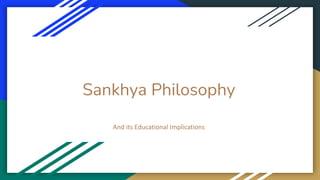
lecturenotesem1_27120231674816939882.pdf
- 1. Sankhya Philosophy And its Educational Implications
- 2. Sankhya Philosophy & sources 1. It is based upon the work of Sage Kapila (written sankhya sutra) 2. Sankhya karika by Iswarkrishna 3. Sankhya karika bhashya by Gaudapada 4. Tattwakaumudi by Vachaspati 5. Sankhya pravachana bhashya and Sankhya sara by Vigyannabhiskhu/ Vijnanabhiksu 6. Sankhya pravachana sutra britti by Aniruddha
- 3. Meaning 1. It is explained in different ways 2. 1st interpretation is that Sankhya refers to Number: because it aims at right knowledge of reality by enumeration of the ultimate objects of knowledge 3. 1st interpretation is that Sankhya means Samyag Jnana - perfect knowledge 4. It also known as dualistic realism- because it recognise 2 types of ultimate realities: Purusha & Prakruti
- 4. Sankhya Theory of Reality 1. Satkarya Vada (Theory of Causation): effect exists In the material cause before it is produced a. Parinama vada (real transformation): when effect is produced there is real transformation of the cause into the effect (pot from clay; curd from milk) b. Vivarta vada( merely apparent): it is when the change of the cause into the effect is merely apparent (statue of any animal)
- 5. 2. Prakruti and Gunas: Prakruti as the ultimate cause of the world of objects a. It constituted of 3 gunas (elements) i. Sattwa:it is of pleasure & is light and bright (evaporation; satisfaction, joy, happiness) ii. Raja: is the principle of activity in things; it is of the nature of pain and mobile; it always moves and makes other things moves (wind blow, fire spread; restless in mind) iii. Tamas: is the principle of passivity & negativity in things; it is heavy opposed to Sattwa and Raja as well; produce ignorance and darkness
- 6. iv. They always go together and never be separated from each other; nor can any one of them can produce anything without support of other 2 v. 3 gunas present in every thing of the world vi. Each of them tries to suppress and dominate the others vii. The nature of things is determined by the predominant guna viii. Gunas are subject to constant change and transformation ix. There are 2 types transformation of guna 1. Swarupaparinama (homogeneous change): change within itself, without disturbing others 2. Virupaparinama (heterogeneous change): interact among gunas
- 7. Purusha (Self) 1. Another ultimate reality according to Sankhya is Purusha (self) 2. Everybody feels s/he exists 3. The feelings of one’s own existence is natural 4. Self is pure, eternal 5. It is different from body, senses, mind and intellect 6. It is a conscious spirit- subject of knowledge; not the object of knowledge 7. Sankhya believe in plurality of selves
- 8. Evolution of the World ● Prakruti evolves the world of objects when it comes into relation with the Purusha ● Combination of 3 gunas in different proportion originates the various objects of the world ● 1st product of evolution is Mahat/ Buddhi (intellect): function is taking decision ● 2nd- Ahankara (ego): consider itself to be an agent/ cause of action, owner of properties ● 3rd- Manas (mind): is the central organ which participate in and consume of the nature of organs of knowledge and action
- 9. ● 4th- 5 organ of knowledge/perception: senses of sight, hearing, smell & touch ● 5th- 5 organs of action: Mouth, Hands, Feet, Excretion organ & Reproduction organ ● 6th- 5 Tanmatras: potential elements of sound, touch, colour, taste and smell ● 7th- 5 Mahabhutas: Prithvi(Earth), Apas( आपः Water), Agni (अि न, Fire), Vayu ( वायु:, Air), Akasha(आकाश, Space/Atmosphere/Ether)
- 10. Sankhya Theory of Knowledge ● Valid knowledge is definite and perfect cognition of object ● Ignorance is the cause of suffering ● Right knowledge of reality liberate from suffering: Jivanmukti & Videhamukti ● 3 sources of valid knowledge ● Perception: direct cognition of an object through sense ● Inference: conclusion draw on the basis of reasoning and evidences ● Testimony: scriptures, texts etc.
- 11. Educational Implications Aims of Education ● Liberation from sufferings ● Knowing the sufferings ● Knowledge about the ultimate realities ● All Round development of personality- physical & intellectual ● Control over sense organs
- 12. Curriculum ● Veda- (Rig, sam, yajur, atharva), upaveda (ayur- medicine & life sc., Dhanur- Warfare, Arthashastra- Business & Admini., Gaandhar- Art, music & Dance) ● Vedanga- Siksha (Phonetics), Vyakarana, Chhanda (linguistics rhythm), Nirukta (etymology), Jyotish (astronomy), Kalps (rituals) ● Natural sciences and social sciences ● Language and Philosophy ● Physical activities ● Scriptures and texts on reality written by eminent personalities
- 13. Methods of Teaching & Learning ● Lecture ● Debate & Discussion ● Sravana: Attentive listening ● Manana: critical thinking ● Swadhyaya: self study ● Exposures
- 14. Role of Teacher & Teacher-Taught Relation ● Teacher as Torch bearer of knowledge ● He is leader and guide ● He must know the path of liberation, person of knowledge about ultimate reality ● Relation b/w teacher and learner should be cordial as father and son
- 15. School & Discipline ● School is the place of learning about realities ● It provides all sorts of exposure to remove darkness and ignorance ● Provide both Paramarthik (liberation) & Laukika (worldly) knowledge ● Advocates for strict discipline but more emphasized on self discipline ● Sanjama ( self control) is to be practised by all